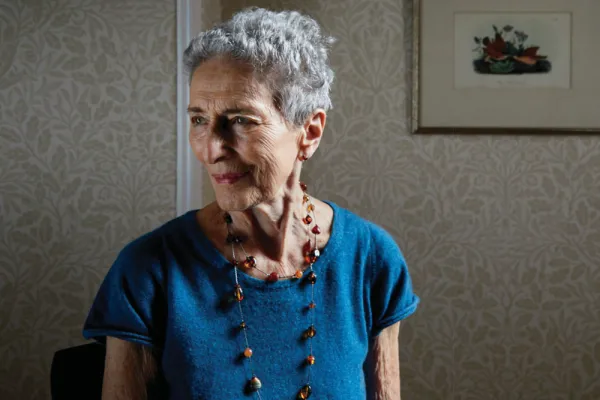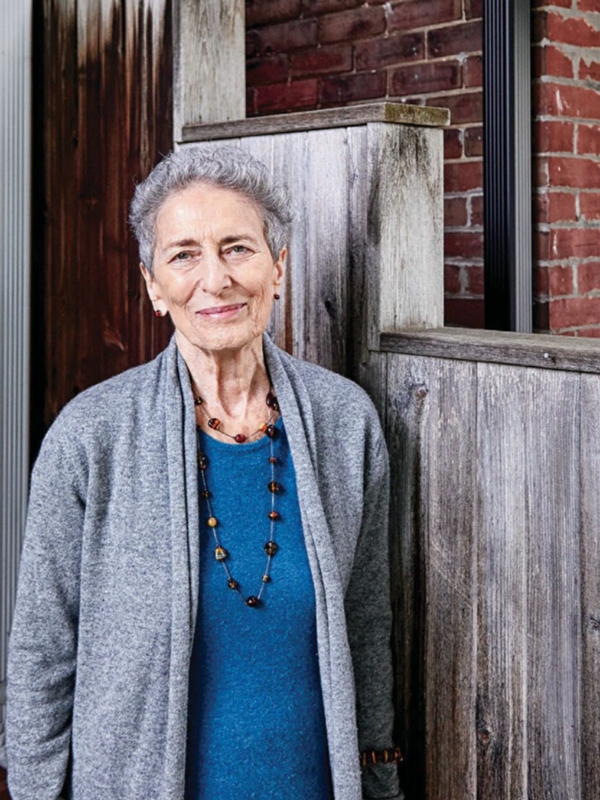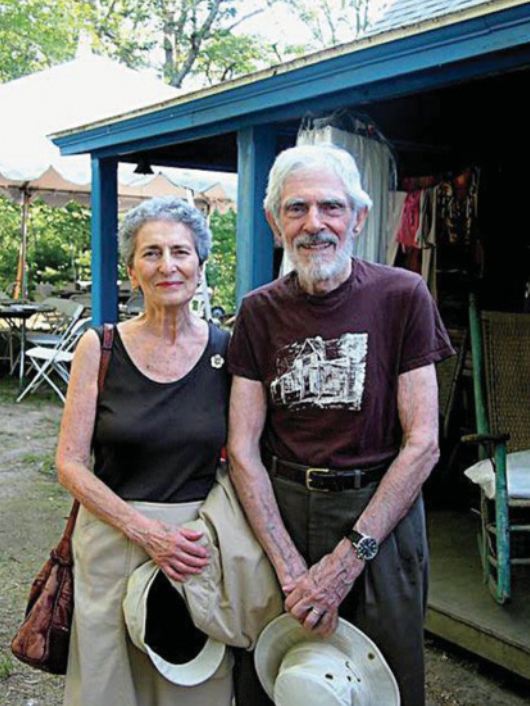The People's Historian
Alum News

Published December 15, 2018
For seven decades, Natalie Zemon Davis ’49 has combed historic archives and rare book collections in search of voices that previous historians ignored: women on the margins who became scientists, merchants and mystics; peasants who enthralled 16th-century Europe with elaborate deceptions as imposters in other people’s lives; workers and artisans who defied the aristocracy and religious power structures through improvisation and cunning.
Davis has said that she writes people into history “as if I were engaged in some rescue mission over and over.” The resulting narratives—which are at once richly inventive and impeccably researched—have transformed our understanding of the early modern world. When Davis won the prestigious Holberg Prize in 2010, the award committee called her “one of the most creative historians writing today.” Her celebrated academic career took her from Toronto in the 1960s to Berkeley in the 1970s to 18 years at Princeton, then finally back to the University of Toronto, where she is professor emerita in the history department. Davis, who was awarded the Smith Medal in 1996, was just the second woman to serve as president of the American Historical Association (in 1987). She’s been named a Companion of the Order of Canada, and in 2012 in the United States she was awarded the National Humanities Medal by President Barack Obama. Here, Davis recalls her life and career, along with some of the voices that have called to her from the past.
AS A CHILD, HISTORY WAS A CLOSED DOOR.
Three of my grandparents were immigrants from Eastern Europe; they didn’t discuss the past. My parents, both born in the United States—my mother in Vermont, my father in Detroit—were loyal to the present and the future, deeply interested in contemporary American culture. To me, the historical past felt like a closed door. When I got to high school, an all-girls school outside of Detroit, I fell in love with my history classes. I was thrilled to study Athenian democracy, the Enlightenment, the American and French revolutions. I remember thinking, “Here it is! Here’s my past!”
 SMITH STOKED MY LOVE OF HISTORY…
SMITH STOKED MY LOVE OF HISTORY…
At Smith, my academic interests just caught fire. In addition to history, I read literature: Tolstoy and Dostoevsky, Marx and Camus, Proust and Sartre. I took sociology, because I was so interested in cultural history. Then I took a class on the Renaissance and Reformation—“Ren and Ref,” we called it—with Leona Gabel. I was fascinated by how near, how present, the past turned out to be. I loved my work so much I barely even noticed we weren’t studying any women!
… BUT IT WASN’T UNTIL GRADUATE SCHOOL THAT I FIRST READ A WOMAN FOR CLASS.
She was Christine de Pizan (1364–1430), whom I suddenly saw as the first European professional literary woman.I loved learning about her, but when my professor at the time encouraged me to write my thesis on her, I didn’t consider it. Christine de Pizan was an aristocrat; I was fascinated by working people—artisans and peasant families who engaged in religious and political action to try to change their lives.
SMITH TOOK ME SERIOUSLY AS BOTH A WOMAN AND A SCHOLAR.
My family did not have an image of me as a professor; that came from Smith. I was involved in so many different areas of campus life, too; I was head of the Young Progressives, a participant in a Marxist discussion group, a member of the American Youth for Democracy. I never had a moment’s doubt that I would have a career and that I would be active in this world. Smith gave me all the support I would later need to survive as an intellectual and a professional.
 I MARRIED THE SUMMER AFTER MY JUNIOR YEAR…
I MARRIED THE SUMMER AFTER MY JUNIOR YEAR…
I met my husband, Chan, at a political meeting while at Harvard Summer School. I’d attended a Students for [Henry] Wallace gathering, and I noticed a handsome guy holding a pingpong paddle. I loved tennis and pingpong, so I thought, “Well, that’s a good sign.” Chan was smart, on the political left, interested in music and poetry, and he liked smart women. We married the summer after my junior year. I remember telling Leona Gabel the news; I suspect she thought, “This is it,” that my career aspirations would end there. Fortunately, I’d married a man who was completely committed to equality.
… BUT I DIDN’T HAVE ROLE MODELS FOR BALANCING CAREER AND FAMILY.
My mother had been a homemaker. My teachers had rich intellectual lives, but no children. I simply didn’t have role models of women who had both a career and children. Together, Chan and I had to carve a life that made space for both the wonders of child rearing and the wonders of academic life. We figured it out as we went along.
OUR APPROACH TO FAMILY/WORK BALANCE CHANGED WITH TIME.
Chan completed his Ph.D. at Harvard as I got my M.A. He was offered a job at the University of Michigan; back then, it didn’t occur to me not to follow him, so in 1950 I continued my studies in Ann Arbor. Twenty years later, though, while Chan taught at the University of Toronto, I was offered a professorship at Berkeley. By then, we had three children. I decided to take the job. Our family spent six years commuting back and forth between coasts. Although we had permanent jet lag, we loved the expansiveness and adventure of these years. Then Princeton offered me a position; after all that cross-continental travel, the commute between New Jersey and Toronto seemed easy!
 HISTORY AFFECTED OUR LIVES AND CAREERS, TOO.
HISTORY AFFECTED OUR LIVES AND CAREERS, TOO.
For my dissertation, I decided to focus on Lyonnais print workers during the Protestant Reformation. I spent six enchanted months combing the archives in Lyon, France. But by the time we returned to Ann Arbor, the Red Scare was in full swing. We’d been involved in some political work, and the FBI visited our house, demanding to know if we were communists. They seized our passports. That was the beginning of a six-year saga during which Chan lost his job, found himself blacklisted by American universities and was ultimately jailed for defiance of the House Un-American A Activities Committee. Professionally, I was devastated by the loss of my passport, cut off from my beloved archives. Nothing was digitized, as it is today. I had no idea how I’d continue my research. But my mother always told me that when things go wrong, one should ask, “Well, what can we do now?”
Natalie and mathematician Chandler Davis were caught up in the Red Scare of the 1950s and eventually moved to Canada.
THIS OPENED UP A WHOLE NEW APPROACH.
I began visiting the rare book collections of the New York Public Library, the Pierpont Morgan and Columbia University. I searched out every book that had been published in 16th-century Lyon, extracting all the information I possibly could. I examined the books’ bindings, marginalia, dedications. I learned everything about the making of the book itself. I began to see how printers disguised Protestant propaganda to slip content past censors and inquisitors. I realized I could put this information to use. I’ve been using this approach—finding the story hidden inside the details—ever since.
THEN I MADE WOMEN THE CENTER OF THE STORY.
I met [the late Smith President Emerita] Jill Ker Conway at the University of Toronto in the 1960s. We were the only two women in the history department then, and the feminist movement was just hitting its stride. Together, Jill and I started the first course in women’s history in Canada. I taught the first term, on women in early modern Europe. Jill taught the second, on women in American history. I scoured rare book libraries to find texts by women. This was exhilarating. We were at once writing women into the historical record, examining the experience of gender and sex in different times and places, and re-evaluating the meaning of movements like the Reformation or the French Revolution. We also began to survey the needs of women graduate students, and to make things better. If there was resistance to our efforts, we didn’t pay attention to it. Nothing was going to stop us.
THEN I DISCOVERED MARTIN GUERRE … AND HIS WIFE, BERTRANDE.
At Berkeley, I came across a book in the law library by the 16th-century judge Jean de Coras. It documented a case of peasant imposture: Years after a man named Martin Guerre left his wife and family in a rural village, an imposter showed up, claiming to be Guerre. The story culminated in a dramatic court case, during which the real Martin Guerre walked through the courtroom door. As soon as I read the account, I wanted it to be a film. I went searching for a director and discovered that Daniel Vigne was interested in the story. Three years later, I was historical consultant to his film Le Retour de Martin Guerre [starring Gérard Depardieu and Nathalie Baye]. I spent months scurrying off to archives to find answers to the actors’ and filmmakers’ questions. We also spent a lot of time discussing Guerre’s wife, Bertrande, who had accepted the imposter as her husband for at least three years. Why? Was she complicit in the deception? Was she duped? I wanted to be sure the film portrayed her as a compelling, plausible 16th-century woman—one that was both crafty and clever.
 THAT MOVIE GAVE WAY TO A BOOK. …
THAT MOVIE GAVE WAY TO A BOOK. …
While the film was beautiful and complex, I wanted to explore Bertrande’s agency more deeply. By this point, I’d also become fascinated by the structure of Judge de Coras’ book. It was so unusual; at times it read almost like a dialogue. I realized that this structure was key to understanding the judge’s mindset. It’s likely the case struck a chord with the judge because he—like so many during this time of social and religious upheaval—was interested in exploring identity, reflecting on what it meant to be able to move across boundaries. I examined all of this in my book The Return of Martin Guerre, which came out just as the movie premiered.
… WHICH THEN GAVE WAY TO NEW PROJECTS.
For years, I’d been examining legal texts, including hundreds of letters requesting royal pardons for homicide. As with Martin Guerre’s case, I realized that all of these letters were a form of narrative storytelling. These stories were crafted by people of all social classes (including those who could not read or write), filtered through scribes, meant to elicit royal sympathies. This study became my book Fiction in the Archives. Future books—Women on the Margins, The Gift in Sixteenth-Century France, Slaves on Screen and Trickster Travels—all employed the same approach: They used single events or biographies as a way of teasing out broader historical truths.
HISTORY IS A SOURCE OF CONSTANT JOY.
The stories I discover in the archives represent our human past. Everything we have—bad as well as good—comes from those people who came before us. They enrich our understanding of who we are, and they inform our lessons about where we might go. They remind us that no matter how bleak things get, people find ways of coping, of improvising. They’re just calling out to be responded to.
This story appears in the Winter 2018-19 issue of the Smith Alumnae Quarterly.
Photo by Derek Shapton